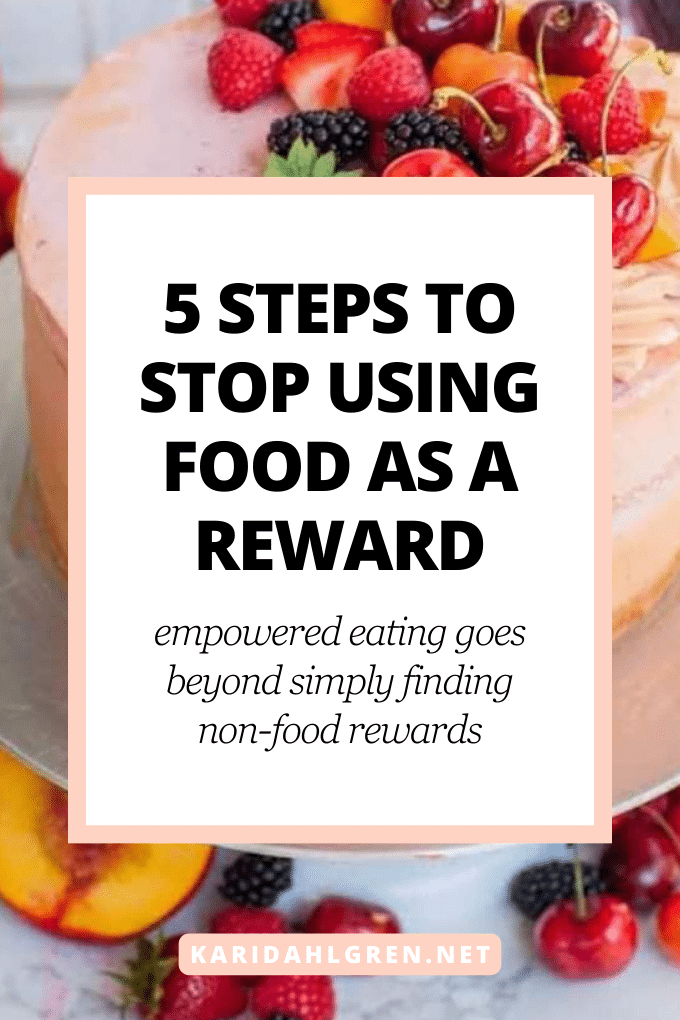
Have you ever reached for a slice of cake or a bag of chips as a treat for getting through a tough day? Many of us are familiar with the ritual of using treats to reward ourselves, and there are many reasons why this habit can feel hard to break.
The foods that we often use as rewards are often hyperpalatable and loaded with fats, sugars, and salts, which light up the brain’s reward system. When we repeatedly reward ourselves with these types of foods, the behavior becomes reinforced, making it even harder to learn how to stop rewarding yourself with food without feeling deprived.
I’ve been there too—sitting at my desk, bargaining with myself: “Just finish the project and you can have that square of chocolate.” At the time, it felt like a form of motivation and even discipline. But in reality, using food as a reward often keeps us stuck in a loop of rules and restrictions that chip away at our personal power.
If you’re wondering how to stop seeing food as a reward without feeling deprived, you’re in the right place. This isn’t about removing joy from eating—it’s about reclaiming your relationship with food in a way that feels nourishing, enjoyable, and empowering.
Why Do We Use Food as a Reward to Begin With?
To understand how to stop using food as a reward, it helps to explore why we do it in the first place. Because the pull toward sweet, salty, and fatty foods isn’t just emotional—it’s deeply biological and psychological. Whether or not you regularly reach for hyperpalatable foods, understanding the brain’s reward circuitry can shed light on why this habit is so hard to break.
The Feel-Good High of Dopamine
Dopamine is one of the main reasons we feel tempted to use food as a reward. When you eat something delicious—especially after finishing a task—your brain releases dopamine, a neurotransmitter that fuels motivation and reinforces behavior. It’s your brain’s way of saying, “That felt good. Do it again.”
But there’s more to the story. According to a study published in The American Psychologist, dopamine plays a much bigger role in “wanting”—the drive to pursue a reward—than in “liking”—the actual pleasure we feel from consuming it.[1] This helps explain why food rewards can feel so compelling.
Hyperpalatable foods tend to activate both systems, creating a double hit of anticipation and satisfaction. Non-food rewards, on the other hand, often spark only one—so they can feel less satisfying, especially in the beginning.
That’s part of what makes it so hard to figure out how to stop rewarding yourself with food—because the foods we most often turn to are designed to light up your brain like a jackpot machine.
Stress Intensifies Cravings for High-Reward Foods
Stress is another reason we gravitate toward food rewards. Research shows that stress alters brain circuits that increase the drive for high-reward foods.[4] If you find yourself promising chips or chocolate as a reward for getting through a rough task, for example, the stress level of that task could be the reason why.
Recognizing this helps us begin the process of learning how to stop seeing food as a reward and start choosing alternatives that don’t feed the stress-craving loop.
Weight Loss Efforts Can Amplify Food Reward Behavior
Speaking of stress, dieting itself can actually intensify the desire to use food as a reward. When we restrict food intake to lose weight, the body becomes more fixated on it—especially high-reward foods. It’s common to fall into a pattern of trying to “earn” indulgent treats by staying disciplined all day, but this strategy can quietly reinforce the very cycle we’re trying to escape.
Not only does this approach ignore hunger cues, it can lead to binge eating, emotional eating, or guilt-ridden patterns where food becomes emotionally loaded. If you’re wondering how to stop rewarding yourself with food while navigating body image goals, the answer lies not in more control, but more compassion, and we’ll dive into specific steps next.
How to Stop Using Food as a Reward: 5 Ways to Apply Eating Psychology
There’s often a good reason behind the habit of rewarding yourself with food—but just because it’s common doesn’t mean it’s helpful. By exploring the psychology behind our eating habits, we can start to untangle the patterns that keep us stuck.
Up next, we’ll walk through five powerful ways to stop using food as a reward—without guilt, restriction, or losing the joy of eating.
1. Make Sure You’re Not Undereating
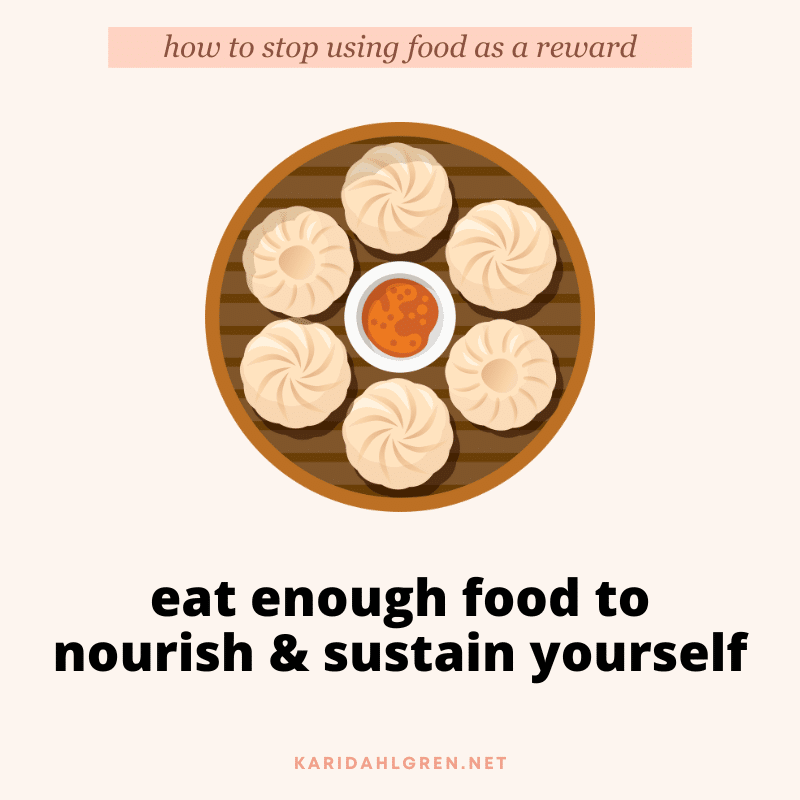
To stop seeing food as a reward, you first have to stop treating it like a luxury. When you don’t eat enough to meet your body’s needs—say, through calorie-restrictive dieting—food starts to feel like a prize, something to be earned, rather than something you’re entitled to by default.
Undereating creates both biological and psychological vulnerability. Physically, it can trigger what some call “famine brain,” where your body ramps up cravings for hyperpalatable foods while slowing your metabolism to conserve energy. Psychologically, it reinforces scarcity thinking—where food feels emotionally charged and harder to resist.
A 2023 study in The International Journal of Eating Disorders found that dietary restraint and even the mental effort to avoid enjoyable foods was a strong predictor of loss-of-control eating.[5]
In other words, just thinking about restricting food—say, by making yourself “work for it” as a reward—can increase the likelihood of overeating.
That’s why the first step in breaking the food-as-a-reward cycle is to give your body enough fuel to feel safe and steady. If you’re constantly underfed, food will continue to hold emotional weight—it will continue to feel like a reward, not a right.
This shift can feel uncomfortable, especially if weight loss is your goal. However, it’s important to recognize that restrictive eating can backfire. Research on set point weight theory shows that your body adjusts its metabolism based on food intake, and long-term restriction can actually raise your set point weight over time—not lower it.[6]
2. Give Up the Food Rules

The next phase in learning how to stop using food as a reward is to let go of the food rules. When we label foods as “bad” or “off-limits,” they become more tempting—not less. This is known as the forbidden fruit effect, and it sets the stage for craving and preoccupation.
Research backs this up. A 2021 study in Eating Behaviors found that people with higher dietary restraint were more likely to overeat when self-control was low—even if they hadn’t actually restricted anything.[7] Just the attempt to avoid food increased the urge to overeat.
Other studies show similar patterns. One in Frontiers in Psychology found that selectively avoiding chocolate led to increased cravings in those who already loved it.[8] Another study in PLoS (Public Library of Science) One showed that depriving people of a favorite food led to frustration, increased desire, and stronger emotional responses around eating.[9]
That’s why food neutrality is so powerful. The less moral weight you place on what you eat, the less emotionally charged those foods become. Over time, this helps you stop seeing food as a reward and start responding to hunger, satisfaction, and enjoyment without guilt.
3. Use Non-Food Reward Strategies
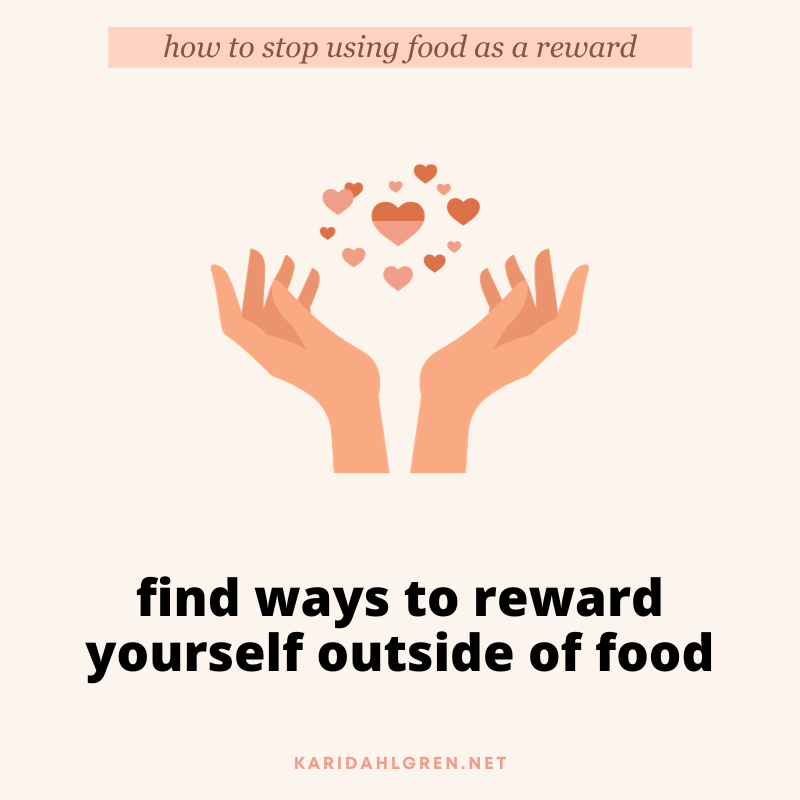
Next up: finding non-food rewards. Notice, however, that this is the third step, not the first. Before exploring non-food reward ideas, it’s essential to make sure your body is nourished and you’ve addressed the psychological patterns that drive cravings. Skipping that foundational work can make non-food rewards feel flat or unsatisfying.
As mentioned earlier, food often hits both the “wanting” and “liking” systems in the brain, which makes it uniquely powerful. A bubble bath or a walk around the block might not feel nearly as rewarding at first—and that’s normal. The goal isn’t to mimic food’s intensity, but to build new habits that feel good enough to support behavior change over time.
Once you’ve removed the scarcity mindset and allowed satisfaction back into your meals, you can explore non-food rewards that align with your values and genuinely feel enjoyable. Some examples include:
- Self-Care Rituals: These can include activities such as taking a short walk (if you find it enjoyable), watching a funny cat video on YouTube, or indulging in a hobby you love.
- Materialistic Rewards: This can be an item you’ve desired for a while, be it a book or a handy gadget. New items can feel good, especially when they align with our values. However, it’s crucial to be mindful of your budget because, just as with food, shopping can become compulsive too.
- Shopping Without the Purchase: Not all rewards need to be purchased. You can get the feel-good experience of consumerism without actually spending money. Ever heard of The Target Effect? It refers to the phenomenon where stores like Target can be enjoyable and mentally rewarding even if you’re just browsing.
And remember, if the reward doesn’t actually feel good, it won’t deliver that satisfying dopamine boost. Don’t force “healthy” habits as stand-ins unless they genuinely feel nourishing in the moment. The key in learning how to stop seeing food as a reward is to build a toolkit of alternatives that feel emotionally honest and sustainably satisfying.
4. Try the Stop, Drop, & Feel® Technique

Sometimes, using food as a reward isn’t just a habit—it can feel compulsive. Even after you’ve nourished your body, challenged your food rules, and identified your favorite non-food rewards, the pull to use food as a reward can still feel too strong to resist.
This is where my Stop, Drop, & Feel® technique comes in. It addresses compulsion by encouraging you pause and feel instead of reacting. At its core, SDF builds emotional tolerance—your ability to sit with discomfort without needing to escape it. Because often, when food feels like the only reward that will do, there’s something deeper beneath the craving: a feeling you’ve been avoiding.
Here’s how it works:
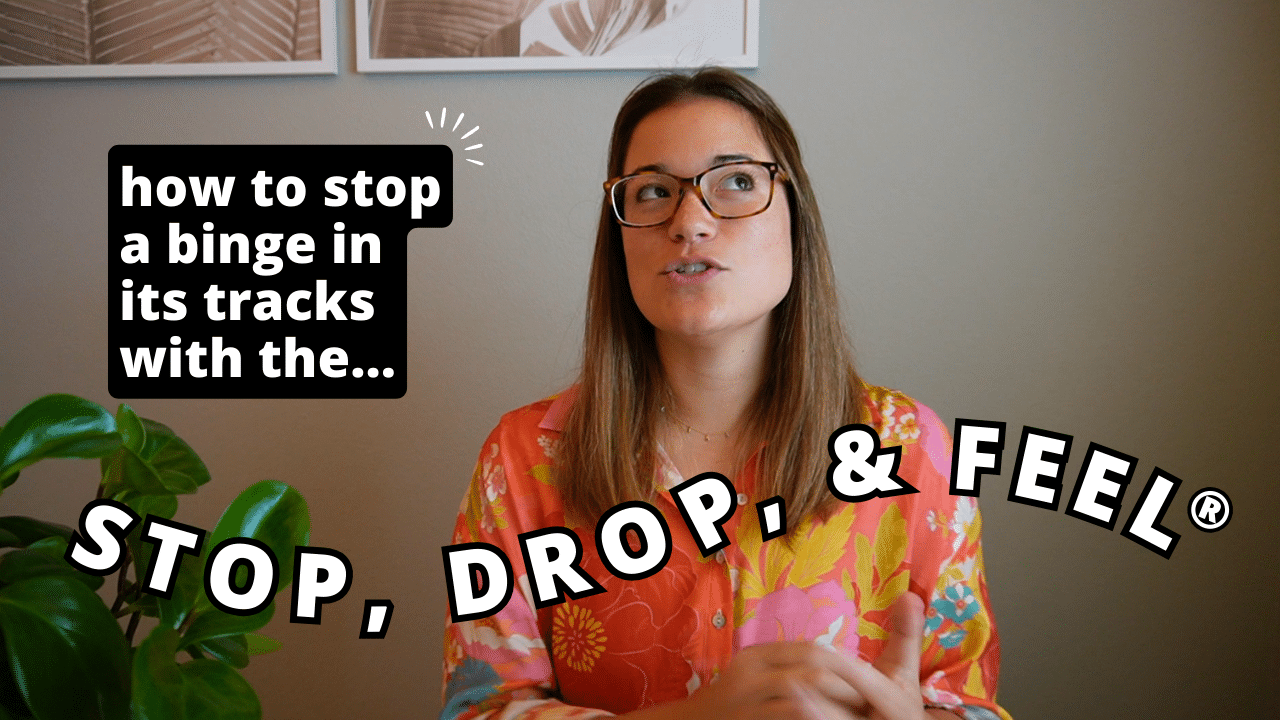
- Stop: The moment you feel the urge to use food as a reward, or any other compulsion, pause. Give yourself permission to eat the food later, after the SDF technique, if that’s what you still want. This helps prevent the restrict-binge cycle and feelings of deprivation.
- Drop: Change your setting, if possible, even if it’s just moving to another room. Set a timer for two minutes and drop into your body. Then, get curious about how you feel.
- Feel: Allow yourself to fully experience whatever emotions bubble up. Avoid analyzing or resisting them. Simply observe the emotions, feel them, and allow them to coexist with you for those two minutes.
The Stop, Drop, & Feel helps interrupt the dopamine-seeking cycle of food rewards by guiding you inward. When you choose to feel instead of react, you build the powerful skill of emotional tolerance. That’s what transforms a compulsive urge into a moment of choice.
Research supports this process. A 2021 study published in Eating Behaviors found that people with higher distress tolerance were better able to regulate emotions and less likely to experience loss-of-control eating—even when dealing with emotional instability.[10] In other words, the more you can sit with discomfort, the less likely you are to experience compulsion, such as the urge to use food as a reward.
5. Practice Mindful, Attentive Eating
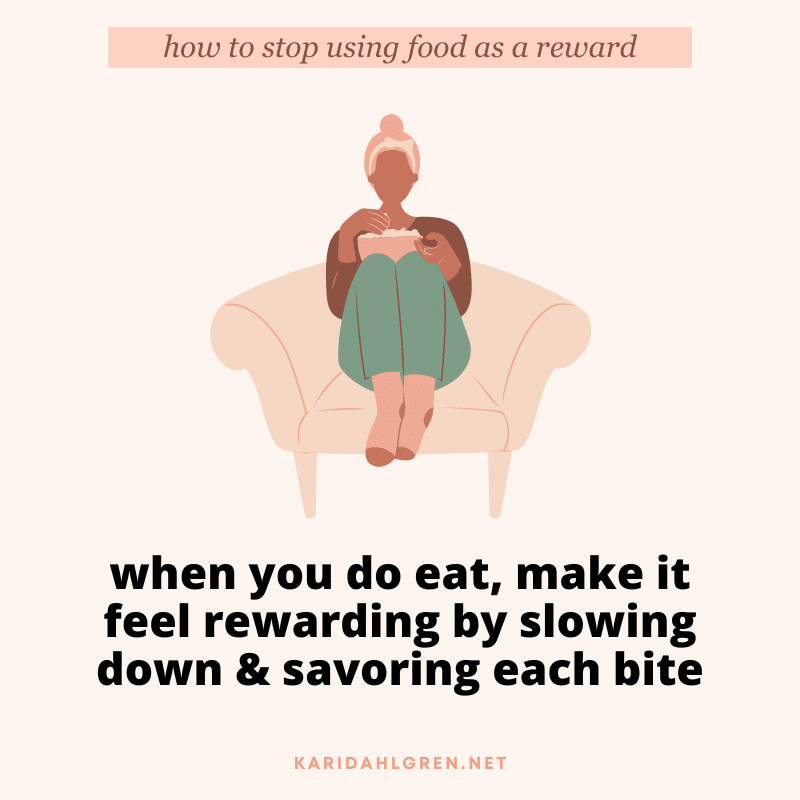
The more we build emotional tolerance, the less we rely on food to soothe or distract. But emotional awareness isn’t just for the moments before we eat—it matters during a meal too. When you approach eating with mindfulness, you meet your needs in real time, which helps reduce the lingering urge to use food as a reward later on.
Mindful eating isn’t about perfection or portion control—it’s about presence. When you’re truly present with your food, it becomes easier to feel satisfied in the moment, rather than needing to “earn” satisfaction by delaying it for later.
Rewriting the Reward
Using food as a reward doesn’t make you weak—it makes you human. In a world where we’re taught to push through and hold it together, it’s no wonder that food becomes the treat we dangle in front of ourselves to get through the day.
But learning how to stop using food as a reward isn’t about giving up the pleasure of eating. It’s about removing the emotional charge so that food can go back to being what it was always meant to be: a source of nourishment and delight—not a bargaining chip.
As you begin to meet your needs in other ways—through rest, through self-awareness, through feeling your feelings and staying present—you may notice that the pull to use food as a reward softens. You might still reach for that chocolate after a long day. But it won’t feel like an emotional crutch. It’ll feel like a choice. A good one.
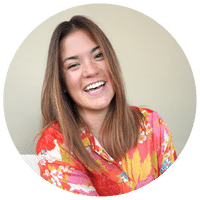
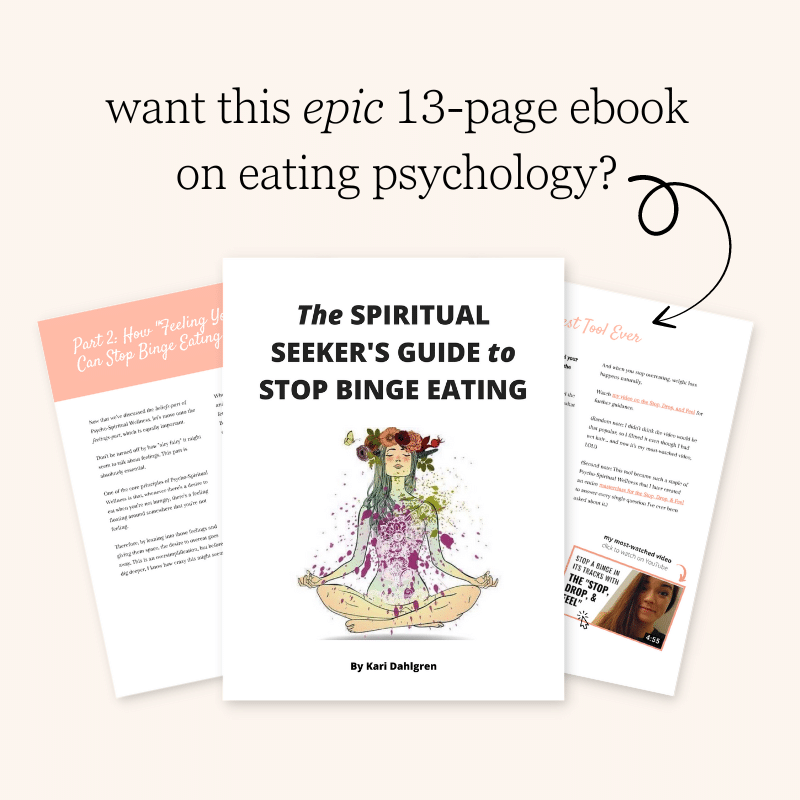


I really loved your article. Like you said I do know what’s healthy and I have used the techniques you have mentioned at home . I struggle on weekends and social situations where I forget all my psychological tricks to not binge or I ignore them. I need to work on this
Thanks for sharing Uma! I am glad you’re already practicing some of these techniques at home, and I wonder if in time they will help with the more challenging occasions like the weekends and social situations, which are indeed more complex than when we are at home. I hope you are offering yourself lots of self-compassion as you navigate this journey. You’re using your tools!! And that alone is worth celebrating. Keep on 🙂
Kari! I just so happened to stumble upon this because I was researching non-food based rewards and I was like “hey I know her!” I’m definitely getting your workbook. Well done, friend! So proud of you!
Shadae!!! It is SO good to hear from you! I only know one Shadae, so I’m pretty sure I know exactly who this is—and it absolutely made my day to see your name pop up. Thank you so much for the kind words and support! I hope life’s been treating you well—and I’m sending you a huge hug!